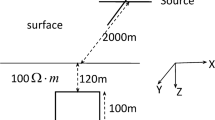Abstract
Magnetic field gradient tensor technique provides abundant data for delicate inversion of subsurface magnetic susceptibility distribution. Large scale magnetic data inversion imaging requires high speed and accuracy for forward modeling. For arbitrarily distributed susceptibility data on an undulated surface, we propose a fast 3D forward modeling method in the wavenumber domain based on (1) the wavenumber-domain expression of the prism combination model and the Gauss–FFT algorithm and (2) cubic spline interpolation. We apply the proposed 3D forward modeling method to synthetic data and use weighting coefficients in the wavenumber domain to improve the modeling for multiple observation surfaces, and also demonstrate the accuracy and efficiency of the proposed method.
Similar content being viewed by others
References
Blakely, R. J., 1996, Potential theory in gravity and magnetic applications: Cambridge University Press.
Burrows, B. L., and Colwell, D. J., 1990, The fourier transform of the unit step function: International Journal of Mathematical Education in Science and Technology, 21(4), 629–635.
Chen, Z. X., Meng, X. H., and Liu, G. F., 2012, The GPUbased parallel calculation of gravity and magnetic anomalies for 3D arbitrary bodies: Geophysical and Geochemical Exploration, 36(1), 117–121.
Chai, Y. P., 1996, Shift sampling theory about Fourier transform computation: Science in China (Series E), 26(5), 450–456.
Eppelbaum, L. V., 2011, Study of magnetic anomalies over archaeological targets in urban environments: Physics & Chemistry of the Earth, 36(16), 1318–1330.
Furness, P., 1994, A physical approach to computing magnetic fields: Geophysical Prospecting, 42(5), 405–416.
Kangaziyan, M., Oskooi, B., and Namaki, L., 2012, Investigation of Topographic Effect on Synthetic Magnetic Data: Istanbul 2012–International Geophysical Conference and Oil & Gas Exhibition., 1–4.
Li, S. L., and Li, Y. G., 2014, Inversion of magnetic anomaly on rugged observation surface in the presence of strong remanent magnetization: Geophysics, 79(2), J11–J19.
Nabighian, M. N., Grauch, V. J. S., Hansen, R. O., et al., 2005, The historical development of the magnetic method in exploration: Geophysics, 70(6), 33–61.
Naidu, P. S., and Mathew, M. P., 1994, Correlation filtering: a terrain correction method for aeromagnetic maps with application: Journal of Applied Geophysics, 32(2–3), 269–277.
Prutkina, I., and Salehb, A., 2009, Gravity and magnetic data inversion for 3D topography of the Moho discontinuity in the northern Red Sea area: Egypt, J. Geodyn., 47(5), 237–245.
Pedersen, L. B., Bastani, M., and Kamm, J., 2015, Gravity gradient and magnetic terrain effects for airborne applications–A practical fast Fourier transform technique: Geophysics, 80(2), J19–J26.
Ren, Z. Y., Tang, J. T., and Kalscheuer, T., et al., 2017, Fast 3D large–scale gravity and magnetic modeling using unstructured grids and an adaptive multilevel fast multipole method: Journal of Geophysical Research, 122(1), 79–109.
Singh, S. K., 1978, Magnetic Anomaly due to a Vertical Right Circular Cylinder with Arbitrary Polarization: Geophysics, 43(1), 173–178.
Singh, B., and Guptasarma, D., 2001, New method for fast computation of gravity and magnetic anomalies from arbitrary polyhedra: Geophysics, 66(2), 521–526.
Tontini, F. C., 2005, Magnetic–anomaly Fourier spectrum of a 3D Gaussian source: The Leading Edge, 70(1), L1–L5.
Tontini, F. C., Cocchi, L., and Carmisciano, C., 2009, Rapid 3–D forward model of potential fields with application to the Palinuro Seamount magnetic anomaly (southern Tyrrhenian Sea, Italy): Journal of Geophysical Research Solid Earth, 114(B2), 1205–1222.
Ugalde, H., and Morris, B., 2008, An assessment of topographic effects on airborne and ground magnetic data: Leading Edge, 27(1), 76–79.
Wang, Y. Z., Wang, R. Q., and Chen, X. H., 2006, Signal analysis and processing: Petroleum Industry Press, China, 46–47.
Wu, L. Y., and Tian, G., 2014, High–precision Fourier forward modeling of potential fields: Geophysics, 79(5), 59–68.
Wu, L. Y., 2016, Efficient modelling of gravity effects due to topographic masses using the Gauss FFT method: Geophysical Journal International, 205(1), 160–178.
Wu, L. Y., and Lin, Q., 2017, Improved Parker’s method for topographic models using Chebyshev series and low rank approximation: Geophysical Journal International, 209(2), 1296–1325.
Wu, X. Z., 1983, The computation of spectrum of potential field due to 3–D arbitrary bodies with physical parameters varying with depth: Chinese Journal of Geophysics, 26(2), 177–187.
Yao, C. L., Hao, T. Y., Guan, Z. N., et al., 2003, High–speed computation and efficient storage in 3–D gravity and magnetic inversion based on genetic algorithms: Chinese Journal of Geophysics, 46(2), 351–361.
Acknowledgements
We thank Dr. Yungui Xu and Dr. Shunguo Wang for help with the English. The editors and reviewers are also thanked for comments and suggestions that improved the manuscript.
Author information
Authors and Affiliations
Corresponding author
Additional information
This work was supported by the National Special Plan for the 13th Five-Year Plan of China (No. 2017YFC0602204-10) and Independent Exploration of the Innovation Project for Graduate Students at Central South University (No. 2017zzts176) and National Natural Science Foundation of China (Nos. 41574127, 41404106, and 41674075) and Postdoctoral Fund Projects of China (No. 2017M622608) and National Key R&D Program of China (No. 2018YFC0603602) and Natural Science Youth Fund Project of the Hunan Province, China (No. 2018JJ3642).
Li Kun graduated from China University of Petroleum (Beijing) in 2013. He presently is a Ph.D. at Central South University. His main research interests are geophysical numerical simulation and inversion imaging.
Rights and permissions
About this article
Cite this article
Li, K., Chen, LW., Chen, QR. et al. Fast 3D forward modeling of the magnetic field and gradient tensor on an undulated surface. Appl. Geophys. 15, 500–512 (2018). https://doi.org/10.1007/s11770-018-0690-9
Received:
Accepted:
Published:
Issue Date:
DOI: https://doi.org/10.1007/s11770-018-0690-9



